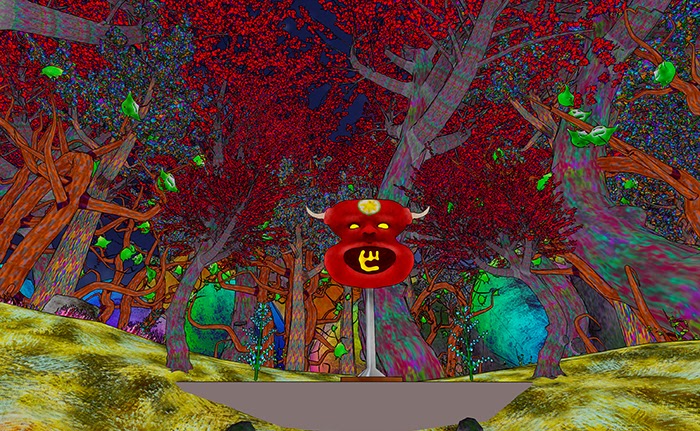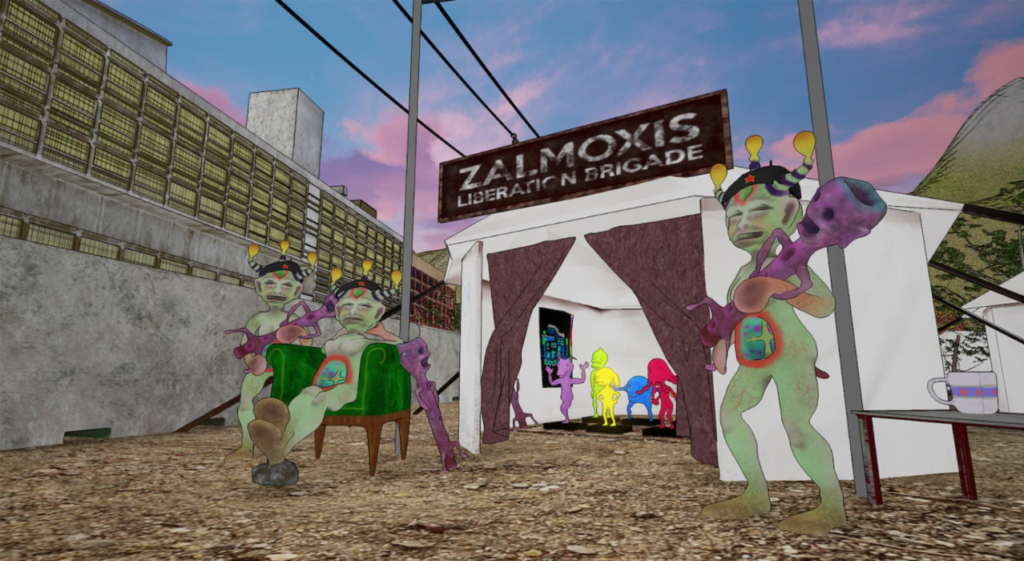Enter an ‘Alien Afterlife’ Inside a Video Game Installation
Aliens and the Tibetan Book of the Dead collide in artist Jeremy Couillard’s latest new media installation.
By DJ Pangburn
February 19, 2017, 7:50am

What if the afterlife is neither total universal awareness nor void, but an alien world? Artist Jeremy Couillard envisions the possibility in Alien Afterlife, a first-person video game installation where players die in a hospital, then find their afterlife hijacked by aliens. This surreal and disorienting world, built with the Unreal Engine 4, is full of odd characters and psychedelic death trip visions.
At Yours, Mine & Ours Gallery in New York City, on the gallery’s first floor, sits an installation built around a projection, including a couch, rug, coffee table and some prints on the walls. Viewers can either play the game or watch a “Let’s Play” of the game, which comes from the year 2056—when smart cars have gone AI and become real estate speculators. A woman has found the game in a forest flea market, and plays it on YouTube to sell ads for money, telling stories about 2056 while drifting through the afterlife. In the gallery, two kinetic aliens type to each other on laptops, trapped in a feedback loop trying to communicate with humans on Earth.
Couillard tells Creators that the Tibetan Book of the Dead was one of the starting points for Alien Afterlife. Coulliard, like many who have read it, found the book difficult to understand. But he does recall a vivid scene where the dead are described as floating around and choosing their mothers for the next life.
“So, there is a scene in the intro of the game where you’re floating above all these monstrous-looking neon mothers,” says Couillard. “And in the top of their heads there are images flashing of what your next life would look like.”

Through the project, Couillard thought a lot about belief. He says that occasionally he feels like he doesn’t believe in very much, while others passionately believe in things like a god or aliens or incarnation. He respects those beliefs and sometimes even envies people who maintain them.
“In this game, I’m mixing the belief in reincarnation with the belief in aliens,” Couillard says. “What if those two systems interacted? Maybe aliens would invade the bardo (afterlife) instead of earth. And the real-time engine (the software to make video games, in this case the Unreal Engine 4) is an ideal tool for setting up a simulation of interacting systems.”
Intersecting with Couillard’s focus on belief are his childhood experiences with The X-Files and the book Communion. Ted Seth Jacobs’s alien portrait on the cover of Communion, in particular, is a work that Couillard sees as the best portrait painting of the late 20th century. He saw it at eight or nine, finding it highly traumatic and building forts to sleep in to hide from the alien all summer long.
Couillard is sad to see a mainstream culture that isn’t quite as interested in aliens and UFOs as it was during the Cold War. That they were probably just a “convenient and entertaining distraction” people invented to explain strange military experiments.
“We built a world almost no one wants but we just keep trudging through it,” Couillard says of the unpredictable era we now live in. “Eight men have as much wealth as 3.6 billion people. Every time I open an Excel spreadsheet I want to cry. Every time I look at a PowerPoint at a work meeting I can feel my soul shriveling up and I don’t even believe in souls.”
“I guess rather than making didactic work about our contemporary situation, I feel more compelled toward constructing absurd cosmologies and analogies where my consciousness can sort of remember it’s human for awhile,” he adds. “We’ve been here before culturally. Society and Its Discontents and Dada are big influences. The couch in the mother body of the video game is Freud’s psychoanalysis room. This could be considered a Dada-esque video game.”
Couillard hopes the contemporary art world will start taking video games more seriously as art. Even if it doesn’t, he believes that the real-time engine will become the dominant art-making tool of the 21st century, much the same way film was in the 20th century. “I’d love for these two disparate groups to want to learn a little more about each other,” he says. “There have been crossovers for decades. I just consider this show one more contribution to that lineage.”
